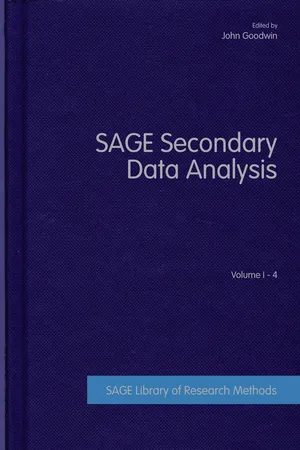Marketing
Secondary Market Research
Secondary market research involves gathering and analyzing existing data and information that has already been collected by others. This type of research is conducted using sources such as industry reports, government publications, and academic journals. It provides valuable insights into market trends, customer behavior, and competitive analysis, helping businesses make informed decisions.
Written by Perlego with AI-assistance
Related key terms
1 of 5
10 Key excerpts on "Secondary Market Research"
- eBook - ePub
The Market Research Toolbox
A Concise Guide for Beginners
- Edward F. McQuarrie(Author)
- 2015(Publication Date)
- SAGE Publications, Inc(Publisher)
THREE Secondary ResearchSecondary Market Research refers to any data gathered for one purpose by one party and then put to a second use by or made to serve the purpose of a second party. Secondary Market Research is thus the broadest and most diffuse tool within the toolbox, because it includes virtually any information that can be reused within a market research context. Secondary research is also the closest thing to an all-purpose market research tool, because virtually every project makes some use of secondary data and almost any decision stage may incorporate some kind of secondary research. As a general rule, relatively speaking, secondary research also is the cheapest and quickest form of market research. You ignore or skimp on it at your peril. Its range of application is limited only by your ingenuity.By the way, most Big Data relevant to marketing research is secondary data. It is rare to see an enormous database compiled to support a particular decision (the definition of primary research). Most commonly, Big Data becomes available either as an off-shoot of some other activity, or because it was cheap and easy to compile, so that a manager at some point said, “Let’s keep track of that stuff.” Many gigabytes later, Big Data results. Although really only a novel form of secondary data, for this fourth edition I’ve devoted a separate chapter to it, immediately following this one.Returning to more traditional forms of secondary research, it is helpful to distinguish between internal and external secondary data. Internal secondary data consist of information gathered elsewhere within your firm. The major categories include (1) sales reports and breakdowns, (2) customer databases, and (3) reports from past primary market research. Sales reports generally give data broken down by product category, region, and time period. More sophisticated systems may give breakdowns by distribution channel, level of price discount, customer type (large, medium, small), and similar categories. The most sophisticated set-ups deliver this data in almost real time in the form of a dashboard available on an executive’s desktop. Dashboard software is an overlay on the underlying database. As sales and related data are entered or updated, the dashboard software produces updated totals and comparisons, often in visual terms. The goal is an up-to-the-minute understanding of how things are going, in an easily digestible form suitable for the busy but hands-on executive. - eBook - PDF
Marketing Research Methods
Quantitative and Qualitative Approaches
- Mercedes Esteban-Bravo, Jose M. Vidal-Sanz(Authors)
- 2021(Publication Date)
- Cambridge University Press(Publisher)
For example, one might include here bibliographies and general indexes, encyclopedias (including Wikipedia), systematic reviews and meta-analysis (combining results from multiple 9781108834988book CUP/ESTEBAN-L1 December 5, 2020 8:48 Page-16 16 Introduction to Social and Marketing Research studies), etc. But the distinction is not particularly relevant and we include them in secondary sources. Firms often commission MR from specialized providers. These companies may offer cus- tomized or syndicated research. Customized research is conducted exclusively for a specific client; the client may participate actively in the design of the study, which is tailored to its needs, and has full access to all results. Therefore, it is generally considered as primary research. By contrast, syndicated research refers to a single type of study conducted by a research company making its results available to multiple companies for sale, and the access may have some limita- tions. It is generally considered as a secondary source. For example, the market research company A.C. Nielsen sells access to pieces of several databases, such as (1) their Scantrack panel database of retailers (from a sample of scanning-equipped chain and large independent grocery stores) and (2) the Homescan panel database (from a sample of consumers scanning the barcodes on their purchases). For scholarly research, a key stage is the study of published literature; but also standard- ized databases. There exist a wide range of academic research documental and socioeconomic databases (see the online resource). 1.3.3 Analyzing Secondary Information Golder (2000) discusses the use of historical archival data in marketing research. Secondary sources might be reliable, but quite often they convey biased results. This is due to several issues. Sometimes a researcher manipulates the data collection process and/or the analysis using ques- tionable research practices, a term popularized by John et al. - eBook - PDF
- V. Kumar, Robert P. Leone, David A. Aaker, George S. Day(Authors)
- 2018(Publication Date)
- Wiley(Publisher)
One of the hallmarks of a competent marketing researcher is familiarity with the basic sources pertaining to the market being studied, coupled with sensitivity to their respective strengths and weaknesses. This means that time will not be lost in an aimless search for nonexistent data, and neither time nor money will be wasted on a premature decision to go into the field to obtain the data. Figure 5.1 shows the principal sources available to a researcher who is responding to a research question or considering what data to collect in order to anticipate future information needs. This chapter deals with externally available secondary sources, for which the specification, collection, Secondary Sources of Marketing Data Secondary Data 99 and recording of the data were done for another purpose by someone other than the user. We will take a particularly close look at census data, because it is so fundamental to understanding all aspects of a market economy. This becomes evident when census data are used to analyze market demand. We will also look at standardized data (Chapter 6), which are collected especially for a set of information users with a common need. Standardized data are both purpose-specific and expensive, but still much cheaper than having each user do it singly. Often, the immediate and unique needs of a decision maker require collecting original, or primary data, which is the topic of the rest of the book. Secondary Data Secondary data are data that were collected by persons or agencies for purposes other than solving the problem at hand. They are one of the least expensive, quickest, and easiest means of access to information. - eBook - PDF
- John Goodwin(Author)
- 2012(Publication Date)
- SAGE Publications Ltd(Publisher)
Bratich Amassing the Multitude 71 Source: Journal of Marketing Education , 23(3) (2001): 195–203. 6 Using Secondary Data in Marketing Research: A Project That Melds Web and Off-Web Sources Stephen B. Castleberry F ew people doubt the often-repeated mantra: information is power in the 21st century. Gary Hamel, corporate CEO and best-selling author, put it this way: “We have gone from an industrial economy to a knowledge economy” (Hamel 1999, p. 4). How can an individual (e.g., a university marketing student) best pos-ition oneself in this new environment? Jeremy Rifkin (1995) suggests that “knowledge workers,” those in our society who “use the most recent informa-tion technology to identify, process, and solve problems,” are being elevated “to center stage in the global economy. They are fast becoming the new aristo-cracy” (p. 175). These knowledge workers are “the creators, manipulators, and purveyors of the stream of information that makes up the postindustrial, post-service global economy” (p. 174). Rifkin assigns them credit and responsibility for keeping our high-tech economy running. How do these knowledge workers get information? In marketing research, it is understood that there are two basic information collection methods: primary and secondary (McDaniel and Gates 2001). By conducting primary market-ing research (e.g., surveys, focus groups, experiments, observation research, in-depth interviews), decision makers can in effect create new knowledge to add to their information array. This is one area in which knowledge workers need to develop skills. 72 Using Secondary Sources and Secondary Analysis Secondary Data Sources However, the rules of efficiency espoused in most marketing research text-books (e.g., Churchill 1999; McDaniel and Gates 2001) suggest that primary research not be the first step. - eBook - PDF
Marketing Research
A Concise Introduction
- Bonita Kolb(Author)
- 2017(Publication Date)
- SAGE Publications Ltd(Publisher)
Marketing Research 100 data to sell. These organizations have the financial and staff resources to be able to conduct a survey with a large enough sample to ensure that data are statistically valid. Academic and government data are often available to a researcher at no cost. Trade association data are usually available only to member organizations, and commercial research data must be purchased. Academic researchers The secondary data that result from studies conducted by academic researchers can most often be found published in academic journals. However, often the studies are basic and not applied research. While such data may provide the researcher with insights as to the causes of a problem, they will rarely answer a research question directly. However, examining the research of others can provide information on some basic questions. Trade associations The secondary data compiled by trade associations are usually specifically focused on the consumers who purchase a product, such as orange juice or women’s fash- ions, sold by member companies. This information can provide very specific and therefore valuable data on consumption trends and changes in consumer preferences. However, because detailed information on consumer preferences would be helpful to competitors selling substitute products, this information may only be available to those companies that belong to the association. Less sensitive data on consumption trends may be available to the general public on the association’s website. South Koreans are Drinking More Coffee While a person might associate Asia with tea drinking, secondary research will show that coffee culture is making an inroad into South Korean society. From 2011 to 2014 the coffee market in South Korea expanded by 50 per cent. In 2014, there was a 17 per cent increase in coffee imports. - Ronald A. Nykiel(Author)
- 2007(Publication Date)
- Routledge(Publisher)
9. R. Daft, Management (Chicago: Dryden Press, 1988), p. 200. 10. http://www2.chass.ncsu.edu/garson/pa765/path.htm and www.NorthCarolinaStateUniversity.com. 11. R. Nykiel, Marketing in the Hospitality Industry (4th ed.) (Lansing, MI: Educational Institute, 2003), pp. 15-16. 12. Ibid., p. 38. 13. http://www.hyatt.com. Defining Marketing Research, Market Analysis, and Applications 23 Chapter 2 Primary and Secondary Research Data CHAPTER OBJECTIVES • To delineate the difference between primary and secondary data. • To discuss primary data collection methodologies. • To identify types of secondary data. • To discuss the usage of internal and external databases. • To provide potential sources for locating data. Research data may be classified as primary or secondary. Primary research is when the re- searcher actually interfaces with the consumer and seeks answers to specific questions, solicits opinions, or actually observes behavior. Secondary research is data obtained from third party sources such as government agencies, syndicated services, and research publications. 1 Both pri- mary and secondary research are discussed in this chapter along with their advantages and short- falls. Further, sources for secondary research and methods to identify and locate secondary data are provided. PRIMARY RESEARCH DATA It is usually wise to begin with a search of secondary research data before embarking on, de- signing, and/or contracting for primary research. It may well be a thorough search of secondary data that provides the researcher the information he or she is seeking. This same thorough re- search may also help shape the parameters of the primary research. Primary research data can be generated through a number of techniques (Figure 2.1). Surveys and Questionnaires Surveys and questionnaires are tools often used when researchers need to identify primary data.- eBook - PDF
- Barry Babin(Author)
- 2018(Publication Date)
- Cengage Learning EMEA(Publisher)
In fact, some restaurants have taken advantage of apps like Waitr to sell a higher pro-portion of meals prepared to go. Other restaurant statistics are produced by NPD each year and show trends in the types of food being purchased in restaurants. These simple facts would interest a researcher who was investigating today’s dining market. Identification of Consumer Behavior for a Product Category Another typical objective for a secondary research study might be to uncover all available information about consumption patterns for a particular product category or to identify demographic trends that affect an industry. For example, a company called Servigistics offers software that scans a company’s own parts inventory data and compares it with marketing objectives and competitors’ prices to suggest potential price adjustments. Kia Motors tried using this service in place of the usual method of marking up cost by a set fraction. By considering secondary data including internal inventory data and external data about competitors’ prices, it was able to make service parts a more profitable segment of its business. 7 This example illustrates the wealth of factual information about consumption and behavior patterns available by carefully considering and analyzing secondary data. Trend Analysis Marketers watch for trends in the marketplace and the environment. Market tracking is the obser-vation and analysis of trends in industry volume and brand share over time. Scanner research ser-vices and Internet analytics firms, as well as other organizations, provide facts about sales volume to support this work. Almost every large consumer goods company routinely investigates brand and product cat-egory sales volume using secondary data. This type of analysis typically involves comparisons with competitors’ sales or with the company’s own sales in comparable time periods. It also involves industry comparisons among different geographic areas. - eBook - PDF
- Donald W. Jugenheimer, Larry D. Kelley, Jerry Hudson, Samuel Bradley(Authors)
- 2015(Publication Date)
- Routledge(Publisher)
P ART II S ECONDARY R ESEARCH IN A DVERTISING AND P UBLIC R ELATIONS This page intentionally left blank 29 5 Introduction to Secondary Research L EARNING O BJECTIVES This chapter is intended to help you: public relations professionals S ECONDARY V ERSUS P RIMARY R ESEARCH When a client asks you to solve a problem with research, he likely doesn’t care if you use secondary or primary research to find the answer. He just wants to know the facts. Or he may want to know the answer in the quickest and most inexpensive manner possible. However, as the one providing the answer, you will need to know not only the difference between primary and secondary research but when to use each approach. When most clients use the term research, they usually are referring to primary research. Primary research is defined as the collection of data that does not already exist. So, primary research is used to find out something that cannot be found out without collecting new information. Secondary research, on the other hand, is defined as the summary, collation, and/ or synthesis of existing data. Secondary research uses existing information to answer the question. The easiest way to think about the differences between the two methods is that primary research involves conducting new research while secondary research involves analyzing existing research. 30 P ART II: S ECONDARY R ESEARCH IN A DVERTISING AND P UBLIC R ELATIONS This doesn’t mean that conducting secondary research is as simple as Googling the topic you are interested in and writing down the result. Conducting secondary research is as rigorous as primary research. In the case of secondary research, you must review a variety of existing information sources rather than conducting a single piece of research. You then summarize what you have found and provide a point of view regarding the information that answers the question posed by your client. - eBook - PDF
Personal Assistance NQF4 SB
TVET FIRST
- T Krul, C Esterhuyse, P Atkins, S Paarman A Rasmus(Authors)
- 2013(Publication Date)
- Macmillan(Publisher)
Module 6 Segmenting a market and undertaking appropriate marketing measures Overview At the end of this module you will be able to: • conduct market research, collate data and evaluate and present it to a mentor. • segment a buying market for a range of products • compose advertising for a target market and select appropriate media for placement. Unit 6 .1: Conducting market research Market research Collating and analysing information about customers, competitors and the market is known as market research. Market research can help with: • creating a business plan • launching a new product or service • expanding into new markets • learning more about existing and potential customers. There are many questions that can be answered through market research, such as: • Who are the customers? • What are the needs of customers? • What is the right price for a product or service? • How frequently do customers buy a product or service? • What do customers think about a product or service? • Who are the competitors and what do customers think about their products or services? There are two types of research: primary research and secondary research. Primary research is about gathering and recording new information. Secondary research is about using data that is already available to make decisions. collating: gathering or bringing together analysing: carefully examining something in order to understand it better Words & Terms 72 Module 6: Segmenting a market and undertaking appropriate marketing measures 73 Module 6: Segmenting a market and undertaking appropriate marketing measures A customer survey A method that is often used for gathering and recording information about customers is a customer survey. A customer survey is a list of questions that customers need to answer (either in writing or verbally) about the product or service of a business. The reason for conducting a customer survey is to collect customers’ opinions regarding a product or service. - eBook - PDF
Dynamics of International Advertising
Theoretical and Practical Perspectives
- Barbara Mueller(Author)
- 2017(Publication Date)
interviews Here, the researcher must watch for and guard against nonresponse bias, topic bias, and social bias, as well as researcher and respondent bias Again, each of these issues will be discussed in greater detail in a later section Data Analysis and Reporting Because secondary data were originally collected to serve other purposes, analyzing requires combining and cross-tabulating various data sets in order for the information to be of use to the researcher In the case of primary data, the information collected must first be edited and coded Care must be taken in applying those analytical tools appropriate to the quality of the data collected Only then can interpre- tation take place Finally, the researcher compiles a report that highlights how the research results relate to the originally stated research problem This report is generally presented to headquarters manage- ment as well as local subsidiaries Secondary Data Secondary data, or pre-existing statistics or information gathered for a purpose other than that of the immediate study, offer some real advantages to the international marketer (Toyne and Walters 1989) Collection and analysis of secondary data are typically the first step in market research for most firms, because a tremendous amount of information can be obtained in this fashion In addition, secondary data generally can be collected fairly quickly and easily, and, most important, relatively inexpensively— most secondary sources provide the information free or for a nominal fee The primary cost, then, for accessing this information can be viewed in terms of the time and energy spent by the research staff Secondary data are particularly valuable for firms planning on entering smaller markets, because their more limited profit potential may permit only modest research expenditures
Index pages curate the most relevant extracts from our library of academic textbooks. They’ve been created using an in-house natural language model (NLM), each adding context and meaning to key research topics.









